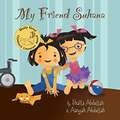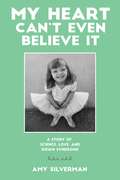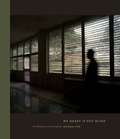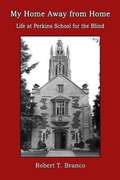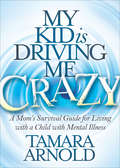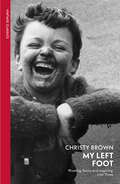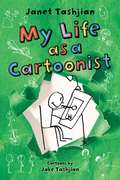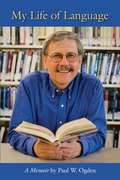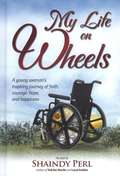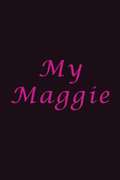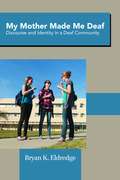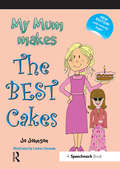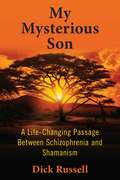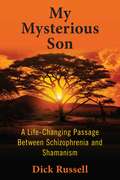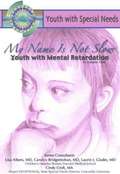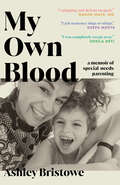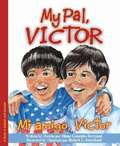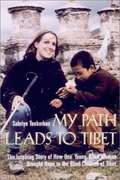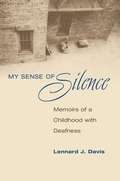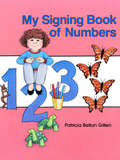- Table View
- List View
My Friend Suhana: A Story Of Friendship And Cerebral Palsy
by Shaila AbdullahA True Story of Friendship and Winner of the Dolly Gray Children’s Literature Award Award-winning author and designer Shaila Abdullah teams up with her 10-year-old daughter Aanyah to bring you this heartwarming tale of a little girl who forms a close bond with a child with cerebral palsy. The girl finds that through her art, she can reach her special friend Suhana.
My Grammy: A Book About Alzheimer's Disease
by Marsha KibbeyWhen eight-year old Amy has to share her bedroom with Grammy who has Alzheimer's disease, she learns to give her the patience she needs.
My Heart Can't Even Believe It: A Story of Science, Love, and Down Syndrome
by Amy SilvermanAll parent stories about raising a child with Down syndrome are special and unique, but in the hands of a good writer, they can have the power to reach, change, and resonate far beyond family and friends. And that is the case with this book by journalist, blogger, and NPR contributor Amy Silverman. Amy bravely looks at her life, before and after her daughter Sophie was born, and reflects on her transformation from a spoiled, self-centered brat, who used words like retard and switched lines at the Safeway to avoid a bagger with special needs, into the mother of a child with Down syndrome and all that her new identity entails. She describes her evolution as gradual, one built by processing her fears and facing questions both big and small about Sophie, Down syndrome, and her place in the world. Funny, touching, and honest, this wonderful book looks at a daughter and her power to change minds and fill hearts with love so deep that, as Sophie once remarked to her mum, I love you so much my heart can't even believe it! Theirs is a story worth reading.
My Heart Is Not Blind: On Blindness And Perception
by Michael NyeMy Heart Is Not Blind: On Blindness and Perception is a collection of stunning portraits of blind and visually impaired people taken by photographer Michael Nye. Each image is accompanied by an intimate story told by the subject concerning his or her experiences and unique perspective. The causes of vision loss range from genetic predispositions (retinitis pigmentosa) or disease (glaucoma) to external circumstances such as accidents (struck by a train) or violence (gunshot wound). The people in this diverse group differ not only in their particular conditions and losses but also in their cultural and socio-economic backgrounds. Taken as a whole, however, the accounts of adapting to changing modes of perception are bound by a common theme of resilience, revealed in shared reactions and unexpected insights. The subjects depicted in My Heart Is Not Blind share their experiences and unique perspectives in a personal narratives that accompany their respective portraits. Most speak of the transition from sight to vision loss, and how that has changed―and not changed―their ability to perceive the surrounding world. Some question the classification of blindness as a disability. One participant proposes that blindness may, in some ways, even aid in perception, musing, “if you can always see the sun, you can never discover the stars.” My Heart Is Not Blind offers a window into the world of the blind and visually impaired, revealing surprising similarities and fascinating differences alongside compelling accounts of survival, adaptation, and heightened understanding. The collection invites us to reconsider what we think we know about blindness in order to gain a deeper understanding of vision and perception.
My Home Away from Home: Life at Perkins School for the Blind
by Robert T. BrancoFrom the ages of 12 to 19, the author attended a school for the blind. He tells about life in the "cottages," academics, sports, field trips, vocational training, and more. He had good and bad teachers, followed wise rules and absurd ones, met good friends and bullies, and welcomed administrative changes. Perkins educated him very well; this book will surely educate and entertain many others.
My Kid is Driving Me Crazy: A Mom’s Survival Guide for Living with a Child with Mental Illness
by Tamara ArnoldMy Kid is Driving Me Crazy helps mothers thrive while living with a child with mental illness. Mental illness in a loved one sucks! Some days, all moms want to do is stay in bed, because facing reality seems insurmountable. Living with her son, who suffers from depression, anxiety, and oppositional defiance disorder (ODD), taught life coach Tamara Arnold how to become the successful woman she is today. Tamara spent years going to therapy, for herself and with her son, learning how to balance living with mental health with having a strong sense of self. My Kid is Driving Me Crazy helps other who are living with people with mental illness learn to separate themselves from the chaos, redefine who they are, and figure out what they want for their future.
My Left Foot: The Life That Inspired My Left Foot
by Christy BrownChristy Brown was born a victim of cerebral palsy. But the hapless, lolling baby concealed the brilliantly imaginative and sensitive mind of a writer who would take his place among the giants of Irish literature. This is Christy Brown's own story. He recounts his childhood struggle to learn to read, write, paint and finally type, with the toe of his left foot. In this manner he wrote his bestseller Down all the Days.
My Life as a Cartoonist
by Janet TashjianTwelve-year-old Derek wants to train his pet monkey to help Umberto, a new student who uses a wheelchair, but Umberto would rather steal Derek's cartoon ideas.
My Life of Language: A Memoir
by Paul W. OgdenPaul W. Ogden has dedicated his life to educating young deaf and hard of hearing people and raising awareness of what it means to be deaf in a hearing world. He has taught and mentored a generation of teachers, and his classic volume, The Silent Garden, has served as a guide for parents and educators for over thirty years. Now he tells his personal story of challenges faced and lessons learned, revealing that the critical, guiding factors for him have always been language and successful communication. Born in a time when many deaf children had no access to language, Paul learned spoken and written language skills at a young age through the painstaking efforts of his mother. His tight-knit family, which included one deaf and two hearing older brothers, facilitated open and constant communication using a variety of methods. His father was a pastor who was involved in the civil rights movement. Despite the family’s closeness, his father struggled with depression, an illness that would take the life of one of Paul’s brothers. As a student at a residential deaf school where the use of American Sign Language (ASL) was suppressed, Paul continued to build on the speech and lipreading skills he had learned at home. He returned home for high school and graduated as co-valedictorian—unaware of the standing ovation he received as he walked to the podium. Following a rewarding experience as an undergraduate at Antioch College, Paul went on to earn a PhD from the University of Illinois, a rare accomplishment for a deaf person at that time. During his graduate studies, he finally had the opportunity to learn ASL. As an award-winning professor of Deaf Studies at California State University, Fresno, he successfully petitioned for the university to recognize ASL as a language, and he established the Silent Garden program, which has grown into a flourishing provider of training and resources to support the Deaf community. In My Life of Language, Paul offers eloquent reflections on both the joyful and difficult periods of his life as he navigated relationships, faced discrimination, questioned his faith, and found great happiness in his marriage.
My Life on Wheels: A Young Woman's Inspiring Journey of Faith, Courage, Hope, and Happiness
by Shaindy PerlBreindy H. is a severely disabled young woman, who must rely on others for her every need. Yet her mind is sharp, intelligent, witty and even humorous. In this book she describes the challenges of life on wheels, her surprising social life, the personal growth of herself and others around her. One should read this book for a boost, a smile, an understanding of life.
My Maggie
by Richard King<P>My Maggie is a rare and real love story. Rich and Maggie King were two people who never gave up on each other-a testament to a love few have the will to attain. <P>She was his childhood sweetheart and wife of thirty-two years. Diagnosed with hearing loss at the age of four, she wore cumbersome hearing aids and felt the humiliation of being "different." Slowly, an insidious disease robbed her of her vision. She fought three different cancers, changed careers in the middle of her life, and fought to realize her dreams. Yet, underneath these great challenges, there was an incredible love shared by two people. It was cemented by adversity and reached a near perfect spiritual connection. They lived a classic old- fashioned love story. <P>King shares one of the most powerful, complex, and memorable love stories ever written. It is an American story of great heroism, courage, and devotion. Maggie was a woman who understood how to lead a happy life and led it, in spite of the challenges placed in front of her. My Maggie is great drama, great passion, and great fun. It is a book written with a love so immense it almost defies description.
My Mother Made Me Deaf: Discourse and Identity in a Deaf Community
by Bryan K. EldredgeThe term deaf often sparks heated debates about authority and authenticity. The concept of Deaf identity and affiliation with the DEAF-WORLD are constantly negotiated social constructions that rely heavily on the use of American Sign Language. However, given the incredible diversity of Deaf people, these constructions vary widely. From Deaf people born into culturally Deaf families and who have used ASL since birth, to those born into hearing families and for whom ASL is a secondary language (if they use it at all), to hearing children of Deaf adults whose first language is ASL, and beyond, the criteria for membership in the Deaf community is based on a variety of factors and perspectives. Bryan K. Eldredge seeks to more precisely understand the relationship between ASL use and Deaf identity using the tools of linguistic anthropology. In this work, he presents research resulting from fieldwork with the Deaf community of Utah Valley. Through informal interactions and formal interviews, he explores the role of discourse in the projection and construction of Deaf identities and, conversely, considers how ideas about language affect the discourse that shapes identities. He finds that specific linguistic ideologies exist that valorize some forms of language over others and that certain forms of ASL serve to establish a culturally Deaf identity. My Mother Made Me Deaf demonstrates that the DEAF-WORLD consists of a multitude of experiences and ways of being even as it is bound together by certain essential elements that are common to Deaf people.
My Mother's Keeper: A Daughter's Memoir of Growing Up in the Shadow of Schizophrenia
by Tara Elgin Holley Joe HolleyDawn Elgin was destined to be a 1940s big-band star. From the time she was fourteen, she took her place at the microphone in Houston's elite Empire Room and sang with the voice of a jazz angel. Vibrant and glamorous, she boldly pursued her love of performing to New Orleans, Hollywood, and New York, where she gave birth to her daughter, Tara, when she was twenty-one. Then Dawn began to suffer persistent visions of a deathly specter at her bedside. She was diagnosed with acute paranoid schizophrenia and began a lifetime spent in and out of institutions. My Mother's Keeper is Tara's deeply moving story of growing up in the shadow of her mother's tragic illness. As Dawn's state worsened, Tara lived in the care of her imperious great-great-aunt Elsa - the family's elderly matriarch, who drew her into a rich world of old-fashioned treasures and Houston history - while her mother drifted in and out of Tara's life like a fading fairy princess. Though Tara yearned for her mother during her childhood, Dawn's condition was usually kept from her, the subject of secretive family discussion and neighborhood gossip. By the time Tara was seventeen she had become Dawn's guardian, bent on rescuing the shambling street person her mother had become and transforming her back into the beautiful, lively woman she remembered. Above all, it is a deeply moving exploration of the mother-daughter bond - of how Tara learned to balance her mother's needs with her own, and how she finally came to terms with Dawn's legacy when she became a mother herself. Emotionally compelling and powerfully rendered, My Mother's Keeper offers indelible proof of love's power to transcend a devastating illness.
My Mum Makes the Best Cakes
by Jo Johnson'How can we talk to our children about Brain Injury?' This is a regularly asked question by parents who have suffered a brain injury and their respective partners. This book has been designed so that children between five and eight can read it independently. However, ideally it should be used with an adult to facilitate discussion about all aspects of family life and to enhance general emotional wellbeing. This book deliberately makes brain injury one of many things going on for this small group of children because for most children it is only one of many issues in their family life. This story is intended to emphasise that all families are different, with their own strengths and weaknesses and different experiences. Brain injury is another experience that some people encounter and others do not. 'My Mum makes the Best Cakes' should prove to be a great reassurance and comfort for children coping with a parent's brain injury. The book presents situations in which brain injured people can be angry, forgetful or unreasonable and shows that it is not the fault of either parent or child and children should not blame themselves. It also demonstrates the positive aspects of life with a brain injured parent and the enjoyable times that can be spent together'. Headway: The Brain Injury Association. "This book has proved to be a very useful support mechanism for service users and families in the Brain Injury Rehabilitation Trust. We are sure that this will continue to be the case, especially with the inclusion of new activity pages." (Professor Michael Oddy, Director of Clinical Services Brain Injury Rehabilitation Trust).
My Mummy is Autistic: A Picture Book and Guide about Recognising and Understanding Difference
by Joanna Grace Heath GraceThis original and imaginative book has been created by five-year-old Heath. In it, Heath illustrates his understanding of his autistic mother Joanna, giving insight into the different ways in which autistic and neurotypical people understand language. In his simple and uncomplicated style, accompanied by bright and colourful illustrations, Heath explains why his mother’s brain understands words at a different rate than his own, and how they communicate in spite of their differences. Heath’s work is accompanied by explanatory notes exploring Joanna’s own experience of autism and language. Key features include: A unique exploration of language processing differences told through the eyes and mind of a child. Bright, colourful pictures and simple language, perfect for inspiring conversations about neurodiversity between people of all ages. Explanatory text that can be read alongside the story. Autism portrayed as a positive and permanent neurological difference, not deficit. The combination of story and commentary makes this book a unique tool for all people seeking to explain and understand difference, regardless of age and experience. Although focusing on autism as an example of neural difference, it can be used to explain and celebrate neurodiversity in all its forms and will help to build relationships across the divide of neurological difference.
My Mysterious Son
by Dick RussellWhat does a father do when hope is gone that his only son can ever lead anything close to a "normal" life? That's the question that haunted Dick Russell in the fall of 2011, when his son, Franklin, was thirty-two. At the age of seventeen, Franklin had been diagnosed with schizophrenia. For years he spent time in and out of various hospitals, and even went through periods of adamantly denying that Dick was actually his father.A mixed-race child, Franklin was handsome, intelligent, and sensitive until his mental illness suddenly took control. After spending the ensuing years trying to build some semblance of a normal father-son relationship, Dick was invited with his son, out of the blue, to witness the annual wildlife migration on Africa's Serengeti Plain. Seizing this potential opportunity to repair the damage that both had struggled with, after going through two perilous nights together in Tanzania, ultimately the two-week trip changed both of their lives.Desperately seeking an alternative to the medical model's medication regimen, the author introduces Franklin to a West African shaman in Jamaica. Dick discovers Franklin's psychic capabilities behind the seemingly delusional thought patterns, as well as his artistic talents. Theirs becomes an ancestral quest, the journey finally taking them to the sacred lands of New Mexico and an indigenous healer. For those who understand the pain of mental illness as well the bond between a parent and a child, My Mysterious Son shares the intimate and beautiful story of a father who will do everything in his power to repair his relationship with a young man damaged by mental illness.
My Mysterious Son: A Life-Changing Passage between Schizophrenia and Shamanism
by Dick RussellWhat does a father do when hope is gone that his only son can ever lead anything close to a “normal” life? That’s the question that haunted Dick Russell in the fall of 2011, when his son, Franklin, was thirty-two. At the age of seventeen, Franklin had been diagnosed with schizophrenia. For years he spent time in and out of various hospitals, and even went through periods of adamantly denying that Dick was actually his father. A mixed-race child, Franklin was handsome, intelligent, and sensitive until his mental illness suddenly took control. After spending the ensuing years trying to build some semblance of a normal father-son relationship, Dick was invited with his son, out of the blue, to witness the annual wildlife migration on Africa’s Serengeti Plain. Seizing this potential opportunity to repair the damage that both had struggled with, after going through two perilous nights together in Tanzania, ultimately the two-week trip changed both of their lives. Desperately seeking an alternative to the medical model’s medication regimen, the author introduces Franklin to a West African shaman in Jamaica. Dick discovers Franklin’s psychic capabilities behind the seemingly delusional thought patterns, as well as his artistic talents. Theirs becomes an ancestral quest, the journey finally taking them to the sacred lands of New Mexico and an indigenous healer. For those who understand the pain of mental illness as well the bond between a parent and a child, My Mysterious Son shares the intimate and beautiful story of a father who will do everything in his power to repair his relationship with a young man damaged by mental illness.
My Name is Not Slow: Youth with Mental Retardation (Youth With Special Needs)
by Autumn LibalFrom the Book Jacket: When Mr. Brown peers through the glass window at his new daughter, she looks impossibly frail in the incubator. The doctors said shehas Down syndrome; she will have mental retardation. But what will that mean for Mr. Brown's daughter? What will she be able to do? Will she ever have talents like his other children? Will she feel joy from her accomplishments-or only pain from her limitations? Mental retardation is one of the most stigmatized disabilities in our society. People living with mental retardation are often treated as if they are simple, emotionless, child-like, or even less than human. And yet, individuals living with mental retardation have hopes and dreams, likes and dislikes, and talents and weaknesses just like anybody else. This book will help you learn about mental retardation, the special needs of individuals living with this form of disability, and the support systems available to help people with mental retardation acquire independence and success. As you read, you will meet Penelope Brown, one girl living with Down syndrome. Follow her story as she struggles both with her medical condition and with the ignorance of others. As you read, you will learn how Penelope and her family experience hope, disappointment, love, loss, and happiness as they learn what it means to live with mental retardation.
My Own Blood: A Memoir
by Ashley BristoweMothering under normal circumstances takes all you have to give. But what happens when your child is disabled, and sacrificing all you've got and more is the only hope for a decent future? Full of rage and resilience, duty and love, Ashley Bristowe delivers a mother's voice like no other we've heard. When their second child, Alexander, is diagnosed with a rare genetic disorder, doctors tell Ashley Bristowe and her husband that the boy won't walk, or even talk--that he is profoundly disabled. Stunned and reeling, Ashley researches a disorder so new it's just been named--Kleefstra Syndrome--and she finds little hope and a maze of obstacles. Then she comes across the US-based "Institutes," which have been working to improve the lives of brain-injured children for decades. Recruiting volunteers, organizing therapy, juggling a million tests and appointments, even fundraising as the family falls deep into debt, Ashley devotes years of 24/7 effort to running an impossibly rigorous diet and therapy programme for their son with the hope of saving his life, and her own. The ending is happy: he will never be a "normal" boy, but Alexander talks, he walks, he swims, he plays the piano (badly) and he goes to school.This victory isn't clean and it's far from pretty; the personal toll on Ashley is devastating. "It takes a village," people say, but too much of their village is uncomfortable with her son's difference, the therapy regimen's demands and the family's bottomless need. The health and provincial services bureaucracy set them a maddening set of hoops to jump through, showing how disabled children and their families languish because of criminally low expectations about what can be done to help.My Own Blood is an uplifting story, but it never shies away from the devastating impact of a baby that science couldn't predict and medicine couldn't help. It's the story of a woman who lost everything she'd once been--a professional, an optimist, a joker, a capable adult--in sacrifice to her son. An honest account of a woman's life turned upside down.
My Pal, Victor / Mi Amigo, Víctor
by Diane Gonzales BertrandTwo Latino boys experience carefree friendship despite one boy's disability. <P><P> Winner of the Schneider Family Book Award
My Path Leads to Tibet: The Inspiring Story of How One Young Blind Woman Brought Hope to the Blind Children of Tibet
by Sabriye TenberkenDefying everyone's advice, armed only with her rudimentary knowledge of Chinese and Tibetan, Sabriye Tenberken set out to do something about the appalling condition of the Tibetan blind, who she learned had been abandoned by society and left to die. Traveling on horseback throughout the country, she sought them out, devised a Braille alphabet in Tibetan, equipped her charges with canes for the first time, and set up a school for the blind. Her efforts were crowned with such success that hundreds of young blind Tibetans, instilled with a newfound pride and an education, have now become self-supporting. A tale that will leave no reader unmoved, it demonstrates anew the power of the positive spirit to overcome the most daunting odds.
My Religion
by Helen KellerHere is a mind kept singularly pure from childhood; here is a religious experience unhampered by the blindness of any sectarianism; here is a spiritual insight, a gift of perception, undulled by absorption in the things of sense life. Here is one in whom the Lord worked a miracle, and Helen Keller declares to us "One thing I know, that whereas I was blind, now I see."
My Secret Life as a Ping- Pong Wizard (Hank Zipzer, the World's Greatest Underachiever #9)
by Henry Winkler Lin OliverHank thought that getting through summer school to get to the fifth grade would be hard enough, but little did he know that it would get worse! Everyone in the fifth grade is starting to focus on a sport--and they're really good. Everyone, that is, except Hank.
My Sense of Silence: Memoirs of a Childhood with Deafness
by Lennard J. DavisLennard J. Davis grew up as the hearing child of deaf parents. In this candid, affecting, and often funny memoir, he recalls the joys and confusions of this special world, especially his complex and sometimes difficult relationships with his working-class Jewish immigrant parents. Gracefully slipping through memory, regret, longing, and redemption, My Sense of Silence is an eloquent remembrance of human ties and human failings.
My Signing Book of Numbers
by Patricia GillenThis full-color picture book helps children learn their numbers in sign language. Each two-page spread of this delightfully illustrated book has the appropriate number of things or creatures for the numbers 0 through 20. The signs for the numbers 30, 40, 50, 60, 70, 80, 90, and 100 are also included. Each sign/number appears in the corner of the page. Written explanations of how to form each sign are provided in the back of the book.
